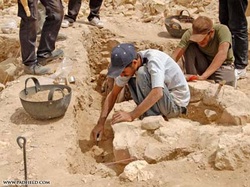What is archaeology?

Archaeology is the study of the human past through the material remains (like the ruins of an ancient building or palace) that have been left behind by those who have lived and died before us. By studying these remains, we learn more about how people in the past lived: what they ate, what they did, what they believed, what they made, and how they moved. Archaeologists* discover these things by doing research; finding places that appear to have ancient remains (pottery, pieces of metal, glass, etc., called artifacts, and building ruins); collecting information by carefully digging to recover artifacts and building remains (called archaeological excavation*); recording (writing down, drawing, photographing) everything they find; studying the recovered items to determine how they were used and what they mean (called analysis* and interpretation* of finds); and writing reports about what they have found and what it means. Many of the more exciting discoveries are published as books or articles for the public (you and me) to read. Unlike treasure hunting, archaeology is really all about the information we get from the "treasures" found, not so much about the treasures themselves.
Why is archaeology important?
Knowing about who lived before us and how they lived helps us to understand where we came from and why our world looks and acts the way it does today. This knowledge we call history, and we can find out about much of our history through written books and articles from the past and present. Archaeology is a companion to history because it is one process that scientists, educators and researchers use to discover more about our history. Sometimes archaeology can tell us new things about people who lived in the past, things that are not yet written in the history books and articles. Also, there were many people who lived before us who did not write about their lives and their things, either because writing had not yet been invented, or they simply did not keep journals or books about themselves and their groups. Only the discoveries made through archaeology can help us to understand them better and, in many cases, make us aware that they even existed. For example, through archaeology, we know that there was a prehistoric* species* of humans who lived more than 40,000 years ago in Europe. They no longer exist today, and we have no written history about them. Today we call them Neanderthals*. They looked much like us today except the shape of their heads and bodies were different in some ways. Without archaeological excavation, we never would have known about them.
* See glossary for definitions.
* See glossary for definitions.
